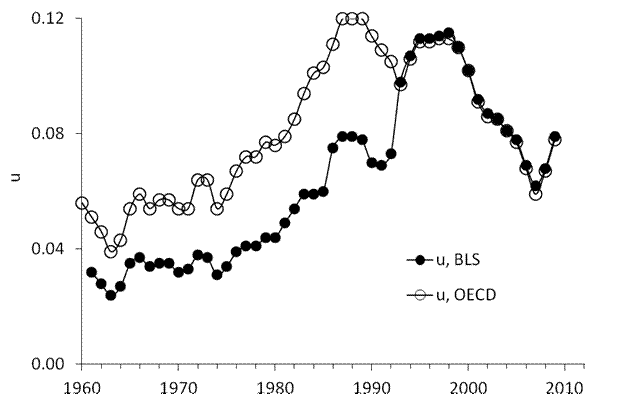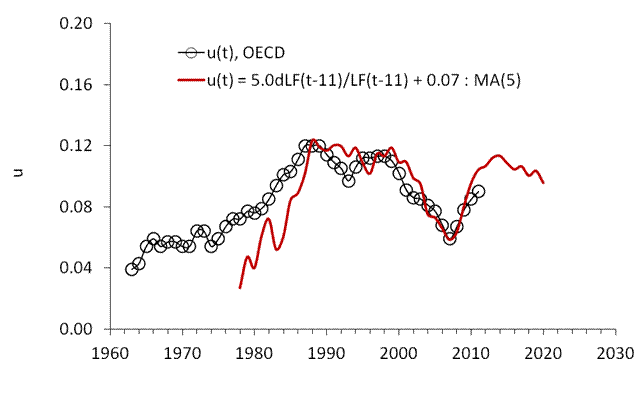A new estimate of unemployment rate in 2011 is now available for Italy. In December 2011, it almost touched 9.0%. Here we validate our model of unemployment as a function of the change in labour force.
We introduced the model of unemployment in Italy in 2008 with data available only for 2006. The rate of unemployment was near its bottom at the level of 6%. The model predicted a long-term growth in the rate unemployment to the level of 11% in 2013-2014.
The agreement between the measured and predicted unemployment estimates in Italy validates our concept which states that there exists a long-term equilibrium link between unemployment, ut, and the rate of change of labour force, lt=dLF/LFdt. Italy is a unique economy to validate this link because the time lag of unemployment behind lt is eleven (!) years.
The estimation method is standard – we seek for the best overall fit between observed and predicted curves by the LSQR method. All in all, the best-fit equation is as follows:
ut = 5.0lt-11 + 0.07 (1)
As mentioned above, the lead of lt is eleven years. This defines the rate of unemployment many years ahead of the current change in labour force. Figure 1 presents two versions of unemployment as defined by the U.S. Bureau of Labor Statistics (BLS) and the OECD. We describe the estimates provided by the OECD (labour force estimates also obtained from the OECD) but have to emphasise that the divergence before 1994 makes it difficult to find a unique model for both agencies.
Figure 2 presents the observed unemployment curve and that predicted using the rate of labour force change 11 years ago and equation (1). Since the estimates of labour force in Italy are very noisy we have smoothed the annual predicted curve with MA(5). All in all, the predictive power of the model is excellent and timely fits major peaks and troughs after 1988. The period between 2006 and 2011 was predicted almost exactly. This is the best validation of the model – it has successfully described a major turn in the evolution of unemployment near its bottom. No other macroeconomic model is capable to describe such dramatic turns many years ahead. As four years ago, we expect the peak in the rate of unemployment in 2013-2014 at the level of 11%.
The evolution of the rate of unemployment in Italy is completely defined ten year ahead. Since the linear coefficient in (1) is positive one needs to reduce the growth in labour force (see Figure 3) in order to reduce unemployment in the 2020s. For the 2010s everything is predefined already and the rate of unemployment will be high, i.e. above 9%. 
Figure 1. The rate of unemployment in Italy as measured by the BLS and OECD.
Figure 2. Observed and predicted rate of unemployment in Italy. 
Figure 3. The rate of growth in labour force.
- English (UK)
- English (India)
- English (Canada)
- English (Australia)
- English (South Africa)
- English (Philippines)
- English (Nigeria)
- Deutsch
- Español (España)
- Español (México)
- Français
- Italiano
- Nederlands
- Português (Portugal)
- Polski
- Português (Brasil)
- Русский
- Türkçe
- العربية
- Ελληνικά
- Svenska
- Suomi
- עברית
- 日本語
- 한국어
- 简体中文
- 繁體中文
- Bahasa Indonesia
- Bahasa Melayu
- ไทย
- Tiếng Việt
- हिंदी
The Rate of Unemployment in Italy - a Well Predicted Rise
Published 02/06/2012, 01:59 AM
The Rate of Unemployment in Italy - a Well Predicted Rise
3rd party Ad. Not an offer or recommendation by Investing.com. See disclosure here or
remove ads
.
Latest comments
Install Our App
Risk Disclosure: Trading in financial instruments and/or cryptocurrencies involves high risks including the risk of losing some, or all, of your investment amount, and may not be suitable for all investors. Prices of cryptocurrencies are extremely volatile and may be affected by external factors such as financial, regulatory or political events. Trading on margin increases the financial risks.
Before deciding to trade in financial instrument or cryptocurrencies you should be fully informed of the risks and costs associated with trading the financial markets, carefully consider your investment objectives, level of experience, and risk appetite, and seek professional advice where needed.
Fusion Media would like to remind you that the data contained in this website is not necessarily real-time nor accurate. The data and prices on the website are not necessarily provided by any market or exchange, but may be provided by market makers, and so prices may not be accurate and may differ from the actual price at any given market, meaning prices are indicative and not appropriate for trading purposes. Fusion Media and any provider of the data contained in this website will not accept liability for any loss or damage as a result of your trading, or your reliance on the information contained within this website.
It is prohibited to use, store, reproduce, display, modify, transmit or distribute the data contained in this website without the explicit prior written permission of Fusion Media and/or the data provider. All intellectual property rights are reserved by the providers and/or the exchange providing the data contained in this website.
Fusion Media may be compensated by the advertisers that appear on the website, based on your interaction with the advertisements or advertisers.
Before deciding to trade in financial instrument or cryptocurrencies you should be fully informed of the risks and costs associated with trading the financial markets, carefully consider your investment objectives, level of experience, and risk appetite, and seek professional advice where needed.
Fusion Media would like to remind you that the data contained in this website is not necessarily real-time nor accurate. The data and prices on the website are not necessarily provided by any market or exchange, but may be provided by market makers, and so prices may not be accurate and may differ from the actual price at any given market, meaning prices are indicative and not appropriate for trading purposes. Fusion Media and any provider of the data contained in this website will not accept liability for any loss or damage as a result of your trading, or your reliance on the information contained within this website.
It is prohibited to use, store, reproduce, display, modify, transmit or distribute the data contained in this website without the explicit prior written permission of Fusion Media and/or the data provider. All intellectual property rights are reserved by the providers and/or the exchange providing the data contained in this website.
Fusion Media may be compensated by the advertisers that appear on the website, based on your interaction with the advertisements or advertisers.
© 2007-2024 - Fusion Media Limited. All Rights Reserved.
